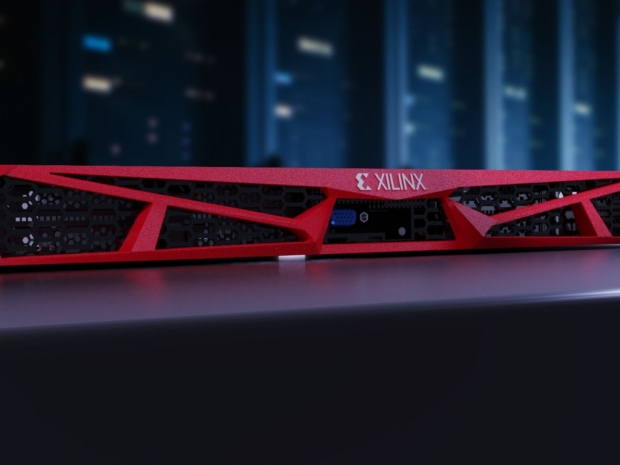
Real-Time Server Appliances for High-Quality, Low-Cost Live Video Streaming
Two things happened since March and COVID 19 virus-induced crisis. Gaming grew, and streaming grew, among total internet use, teleconferencing, and home office explosion. Xilinx announced two real-time server appliances to offer high quality, low-cost live video streaming platform.
Global live video streaming TAM was $26B in 2019. The pre-Covid19 analysis predicted that the market would grow to $31B in 2020, and with adjustment probably more. There is a steep total amount of market increase as in 2026, Mhojhos Research expects the market to grow to $94B in 2026. The market can potentially grow by more than three times from today’s numbers.
Netflix, HBO, Spotify, and ESPN and have a smaller user base than YouTube Gaming and Twitch game-streaming platforms. Gamers today love to see others playing and commenting on the games.
Saving private Bandwidth
The main cost element in live streaming is the bandwidth, as managing to save 30 percent of the bandwidth can save tens of millions of dollars, and using the right tools and compressions, the quality can remain visually identical.
Huya, the Twitch of China, claims that the bandwidth costs rose by 40% to $32.4 million during the last quarter of 2019. This was due to an increase in users and an effort to improve video quality.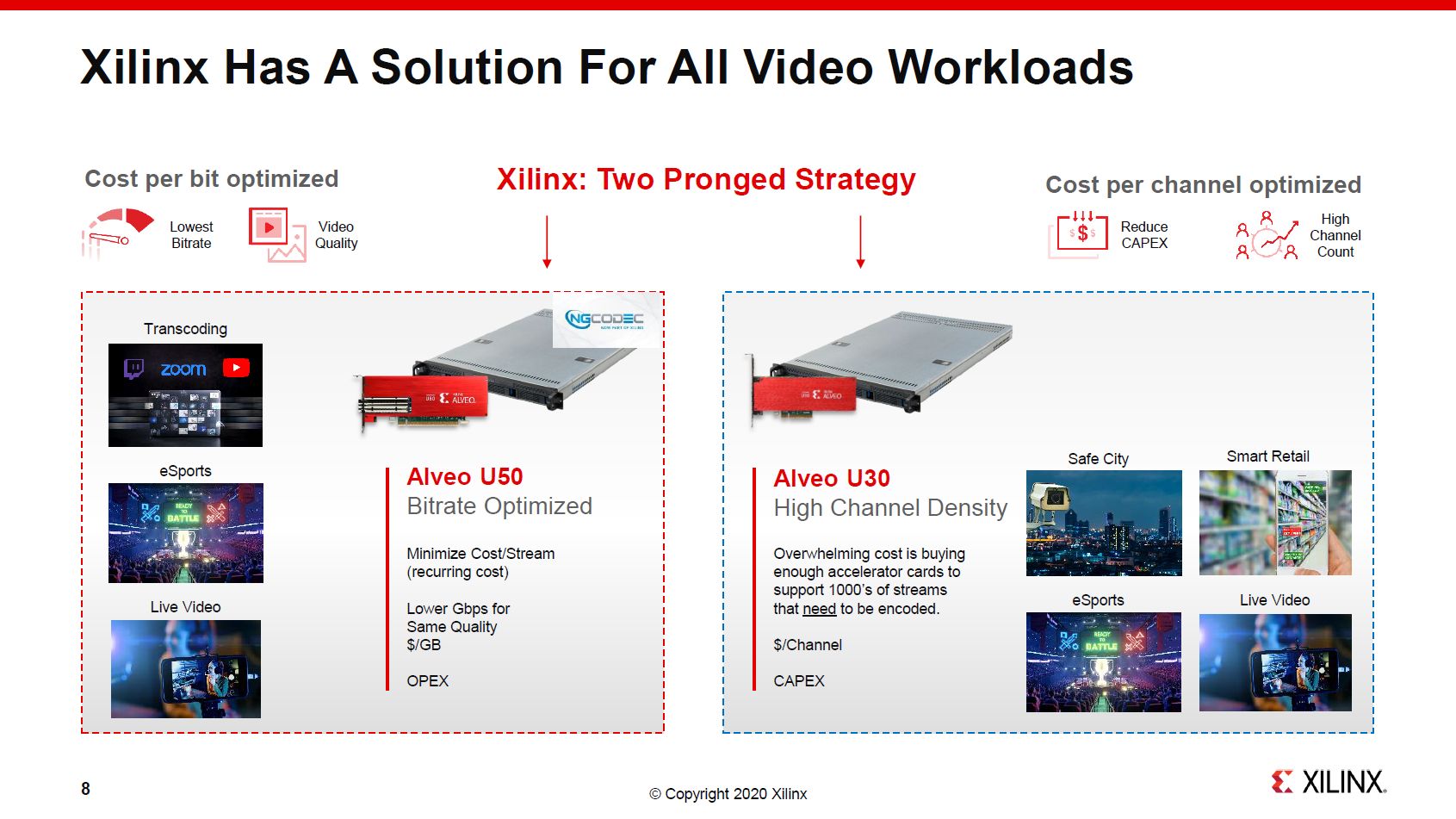
We had the time to chat with Aaron Behman, Director of Video Product Marketing, Data Center Group at Xilinx, and learn a bit about the new product portfolio targeted at the streaming platform.
One of the issues that drive the cost is that the 100s of channels phenomenon despite being the small component of the overall user numbers can result in a tremendous amount of viewership. Top twenty percent of subscribers will consume the top 80 percent of the streaming platform. It results in a massive spike of hardware needs and cost.
Xilinx Real-Time (RT) Server Reference Architecture -Transcoding Editions
Xilinx is executing its Datacenter first strategy and has just announced two Xilinx Real-Time (RT) Server Reference Architecture focused on either bit rate or high channel density.
The application spectrum covered by this server appliance, ready to go to the data center, includes live broadcast, telemedicine, distance learning, eSports and live gaming, live streaming, social video networking, and live sports broadcast. The timing could not be better as COVID 19 has taught us the importance of every single application mentioned above as the market realizes that many things can be done from the comfort of your home.
Designed for edge and on-premise compute-intensive workloads where video channel density, throughput, and latency are critical requirements, the new Xilinx Real-Time Video Appliances feature optimized hardware architectures and software to deliver the industry highest channel density and lowest latency performance. The appliances are available in two pre-configured options integrating Xilinx®Alveo™data center accelerator cards–the High Channel Density Video Appliance and the Ultra-Low Bitrate Video Appliance.
“As the volume of video streaming increases exponentially, optimized architectures are becoming critical,” said Donna Yasay, vice president of marketing, Data Center Group, at Xilinx. “We’re all experiencing this today in the current COVID-19remotework, learn and play environment–the massive increase in concurrent channel usage is taxing service provider business models and driving up bandwidth costs. With these new reference architectures, Xilinx is enabling solution providers to maximize cost savings, while delivering high-quality video streaming services.“
Two server appliances are based around Alveo U50, bitrate optimized, or Alveo U30 high channel density optimized server appliance. The Alveo U50 bit rate optimized solution Minimize Cost and Stream recurring cost as it can Lower Gbps bandwidth for Same Quality per dollar and GB.
Platforms benefiting from Alveo U50 solution include video chat late bloomer Zoom, Twitch, YouTube, as well as any eSports and Live video providers. All transcoding is based on Xilinx owned NGcodec.
The Alveo U30 based solution aims to optimize cost per channel and user. It can reduce CAPEX and offer high channel count. The target group for this solution are smart cities, smart retail, eSports, and Live video.
Alveo U30
The Alveo U30 is a High-Density PCIe Solution for media processing & machine learning. It is a Half-Height / Half Length, Single Slot card. It is essential to mention that this is a low power solution resulting with sub 40 W card full load.
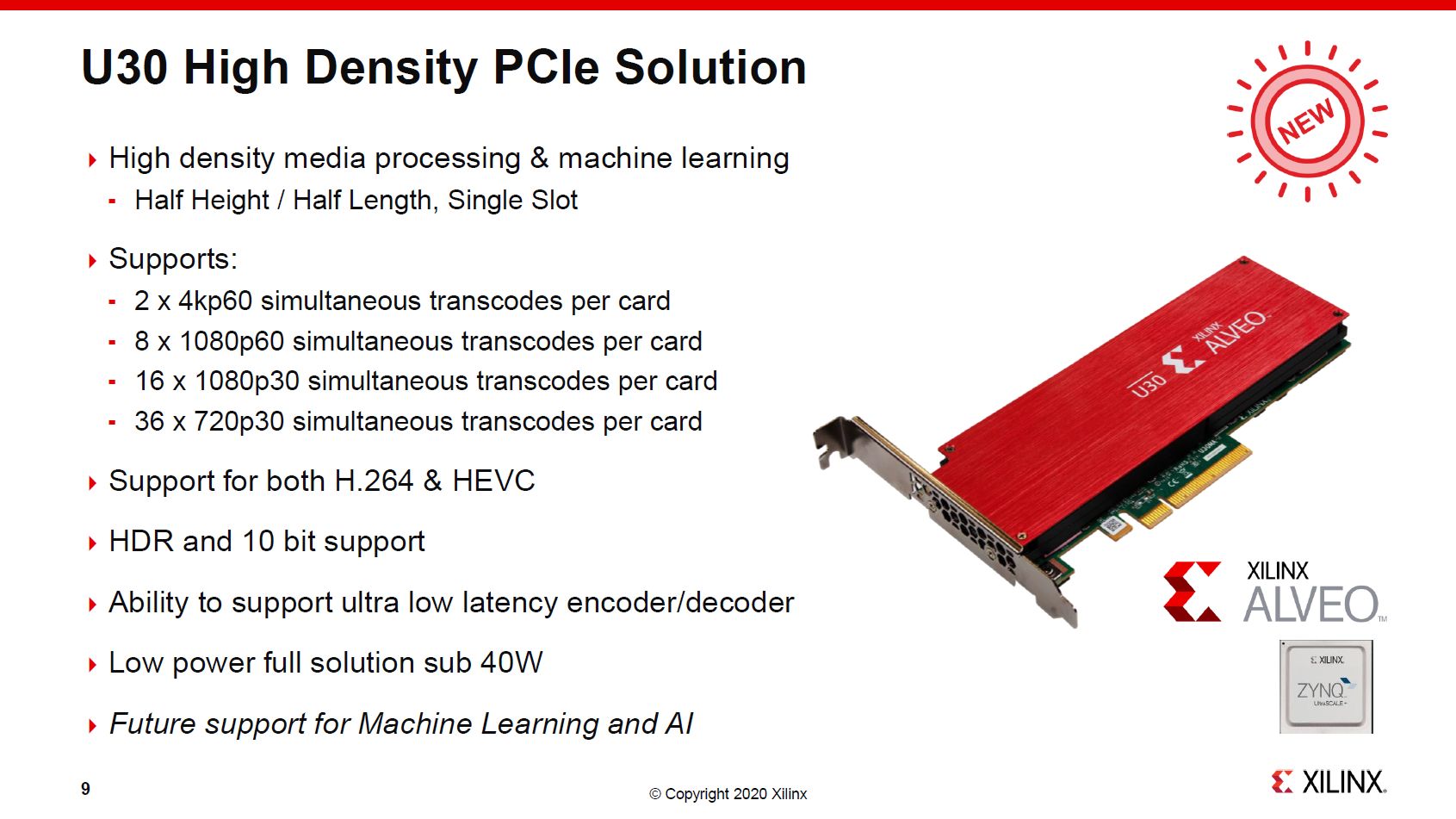
Alveo U30 supports:
2 x 4kp60 simultaneous transcodes per card
8 x 1080p60 simultaneous transcodes per card
16 x 1080p30 simultaneous transcodes per card
36 x 720p30 simultaneous transcodes per card
The AlveoU30 card is powered by the Zynq®UltraScale+™MPSoC, a power-optimized all-programmable system-on-chip (SoC) with integrated video codec and graphics engines for ultra-high-definition video. Alveo V30 support for both H.264 & HEVC (H.265) codecs, HDR, and 10-bit support. It has the ability to support ultra-low latency encoder/decoder, and in the future, it will be able to support machine learning and AI.
Alveo U50
The Ultra-Low Bitrate Optimized Video Appliance is purpose-built for the high-quality live video while reducing bandwidth costs. It contains up to eight Alveo U50 accelerator cards. Built on Xilinx®UltraScale+™ architecture and packaged in an efficient 75-watt, low-profile form factor, the AlveoU50 card includes 8GB HBM2, 100GbE networking and a PCI Express 4.0 interconnect. It is capable of streaming up to seven full-HD 1080p60 channels along with eight full ABR ladders (all at x265 medium preset).
These new appliances are built on the FFmpeg framework to allow for the rapid replacement of existing software and GPGPU-based transcoder infrastructure by providing system developers with a common API. It is as simple as changing the name of a container, and the FPGA figures our the rest for you.
Software partners are engaged to build applications to run above the standard FFmpeg layer. The HEVC codec is rebuilt from the ground up in a componentized manner to allow for better control of the codec down to the frame level. This allows system integrators to adjust rate control and fine-tune other parameters to optimize video quality and bitrate to suit the particular end application. This unique flexibility offered by adaptive compute devices is not possible with ASIC-based options. Both appliances offer up toa 4x reduction in cost, footprint, and power for H.264 at 1080p30 resolution and x264 medium preset.
The Xilinx RT Server reference architectures are built with optimized hardware architectures and software stacks, from the gate-level up to the software and AI stacks, to maximize performance for specific workloads. Available in a 1RU rackmount form factor, both appliances support complete Docker container and Kubernetes management capability to enable easy scale-out deployments.
Competition
Let us mention some numbers over the Nvidia T4 based solution. Alveo U50 quality and bit rate optimized solution has higher quality in real-time streaming and still offers a 30 percent bitrate reduction over any real-time competitor. The solution targets a few sources with many viewers.
Alveo U30 optimized for density is equivalent to Nvidia T4 quality and offers higher density and consumes 20 percent less power. Xilinx U30 with 2 ZU+ processors supports 16 streams in H.264 and HEVC, while Nvidia T4 only supports ten streams in H.264 and four in HEVC.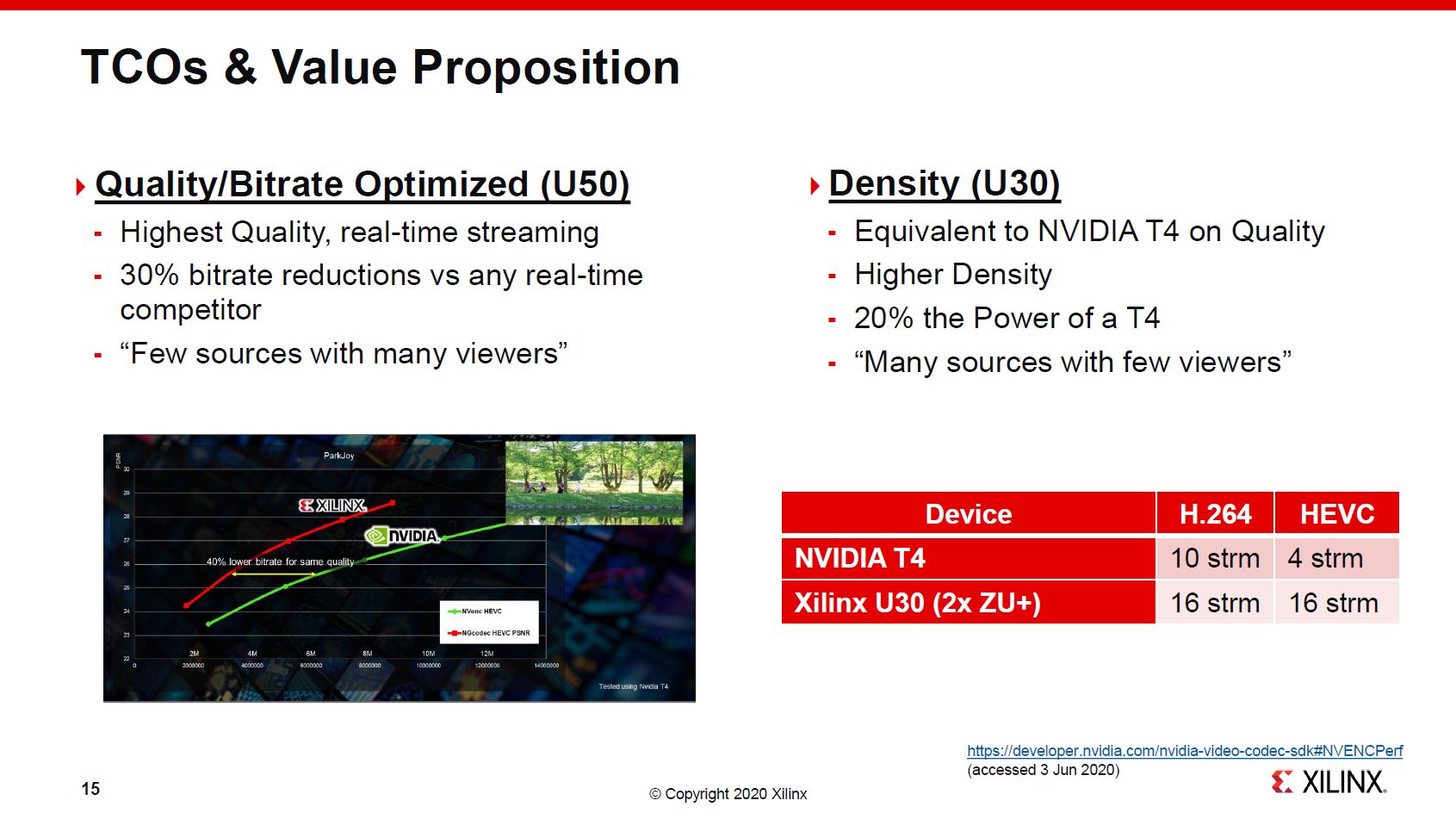
Live transcoding 1080p120 HVEC
Using X265 slow codec optimized for quality one HP ProLiant DL385 server with eight Alveo U50 cards and Dual AMD EPYC 7262 can outrun five HPE ProLiant DL380 servers based on ten 8275CL 3.0GHz CPUs. Using the same settings with slow, high-quality HEVC at 14X ABR @ 1080p30 Alveo based HP ProLiant DL385 server offers five times throughput per node, six times lower hardware cost and three times lower power.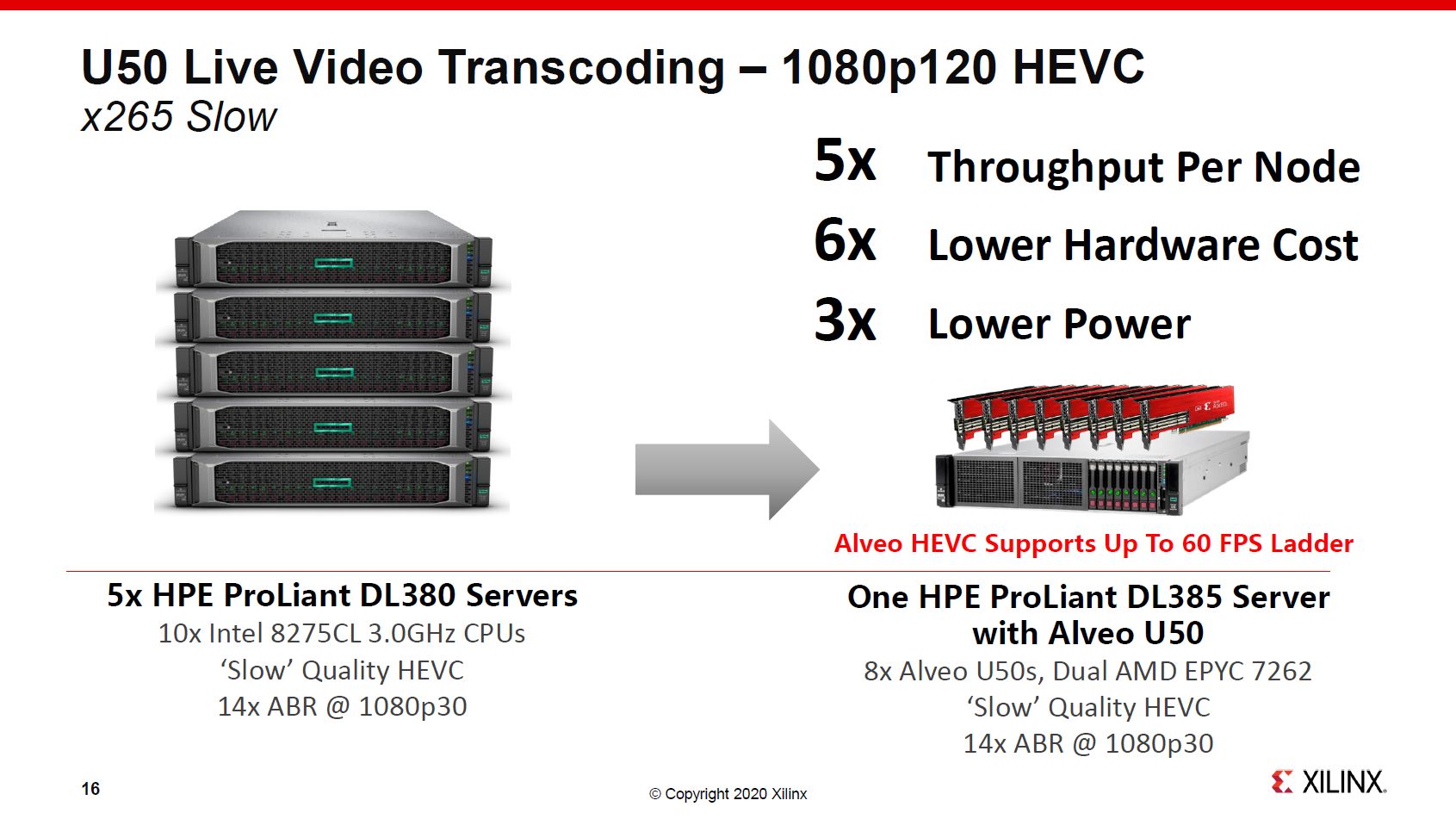
HPE ProLiant server qualifications and ISV support
HPE has qualified the Alveo U50 and Alveo U250accelerator cards on the HPE ProLiant servers.TheHPE ProLiant DL380 Gen 10 and HPE ProLiant DL385 Gen 10 Plus servers will be the first Xilinx FPGA-powered HPE servers. HPE will be the first tier-one server OEM to offer the bitrate optimized Alveo U50-based video transcoding appliance. The qualification of Alveo cards on HPE servers adds to a growing list of OEM server partners and ISV applications published on the Alveo platform for accelerating cloud and on-premise workloads.
“Today’s compute-intense workloads are driving the demand for differentiated video transcoding, video analytics, and database acceleration solutions,” said Michael Mangiafico, Compute Accelerator Strategist, HPC, and MCS, at HPE. “By collaborating with Xilinx to offer Alveo accelerator-supported products in HPE ProLiant servers that are high-performing and versatile, we are enabling a market-ready solution to power a range of capabilities for emerging live-streaming applications.
”Xilinx value-added resellers are integrating the Wowza Streaming Engine™media server into RTServer-based appliances. This web-based GUI application lets users manage live streaming video in an easy and intuitive way. Integration is expected to be complete and available in the third quarter of this year.“Wowza is working closely with Xilinx and its VARs to integrate the Wowza Streaming Engine media server into RT Server-based appliances. This integration will, in the future, offer a complete solution for cost-effective and easy management of live video streaming,” said Anthony Lazaro, senior director of product, at Wowza.“
Availability
The Xilinx RT Video Appliances are currently available through an authorized Xilinx value-added reseller (VAR) or server OEM.
One of the first VARsto have an appliance optimized on the Xilinx RT Server reference architecture is Hypertec, with its CIARA family of appliance focused on the video transcoding market.
“We’ve collaborated closely with Xilinx on the release of our upcoming 2U CIARA Appliance designed with a single socket AMD processor that supports up to seven new Alveo U30 accelerator cards,” said Benoit Robert, vice president of marketing at Hypertec. “Together with Xilinx, we’re excited to be delivering a purpose-built live video streaming appliance that will offer unprecedented channel density to support customers looking to scale-up their video streams for more cost-effective infrastructure deployments.”